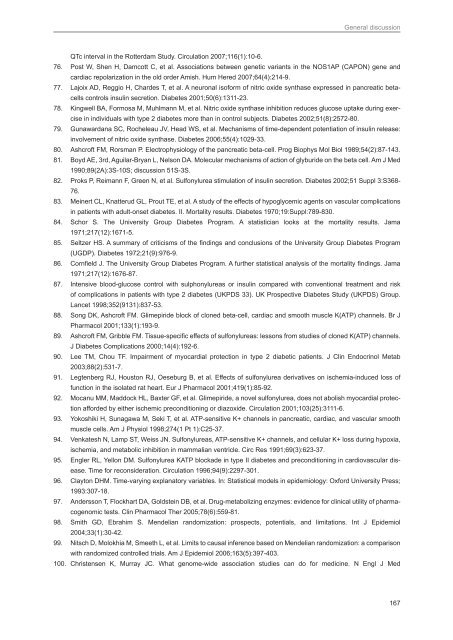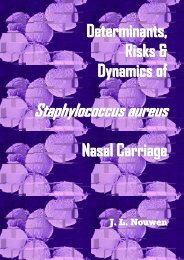Genetic susceptibility to adverse drug effects - Epidemiology ...
Genetic susceptibility to adverse drug effects - Epidemiology ...
Genetic susceptibility to adverse drug effects - Epidemiology ...
Create successful ePaper yourself
Turn your PDF publications into a flip-book with our unique Google optimized e-Paper software.
General discussion<br />
QTc interval in the Rotterdam Study. Circulation 2007;116(1):10-6.<br />
76. Post W, Shen H, Damcott C, et al. Associations between genetic variants in the NOS1AP (CAPON) gene and<br />
cardiac repolarization in the old order Amish. Hum Hered 2007;64(4):214-9.<br />
77. Lajoix AD, Reggio H, Chardes T, et al. A neuronal isoform of nitric oxide synthase expressed in pancreatic betacells<br />
controls insulin secretion. Diabetes 2001;50(6):1311-23.<br />
78. Kingwell BA, Formosa M, Muhlmann M, et al. Nitric oxide synthase inhibition reduces glucose uptake during exercise<br />
in individuals with type 2 diabetes more than in control subjects. Diabetes 2002;51(8):2572-80.<br />
79. Gunawardana SC, Rocheleau JV, Head WS, et al. Mechanisms of time-dependent potentiation of insulin release:<br />
involvement of nitric oxide synthase. Diabetes 2006;55(4):1029-33.<br />
80. Ashcroft FM, Rorsman P. Electrophysiology of the pancreatic beta-cell. Prog Biophys Mol Biol 1989;54(2):87-143.<br />
81. Boyd AE, 3rd, Aguilar-Bryan L, Nelson DA. Molecular mechanisms of action of glyburide on the beta cell. Am J Med<br />
1990;89(2A):3S-10S; discussion 51S-3S.<br />
82. Proks P, Reimann F, Green N, et al. Sulfonylurea stimulation of insulin secretion. Diabetes 2002;51 Suppl 3:S368-<br />
76.<br />
83. Meinert CL, Knatterud GL, Prout TE, et al. A study of the <strong>effects</strong> of hypoglycemic agents on vascular complications<br />
in patients with adult-onset diabetes. II. Mortality results. Diabetes 1970;19:Suppl:789-830.<br />
84. Schor S. The University Group Diabetes Program. A statistician looks at the mortality results. Jama<br />
1971;217(12):1671-5.<br />
85. Seltzer HS. A summary of criticisms of the findings and conclusions of the University Group Diabetes Program<br />
(UGDP). Diabetes 1972;21(9):976-9.<br />
86. Cornfield J. The University Group Diabetes Program. A further statistical analysis of the mortality findings. Jama<br />
1971;217(12):1676-87.<br />
87. Intensive blood-glucose control with sulphonylureas or insulin compared with conventional treatment and risk<br />
of complications in patients with type 2 diabetes (UKPDS 33). UK Prospective Diabetes Study (UKPDS) Group.<br />
Lancet 1998;352(9131):837-53.<br />
88. Song DK, Ashcroft FM. Glimepiride block of cloned beta-cell, cardiac and smooth muscle K(ATP) channels. Br J<br />
Pharmacol 2001;133(1):193-9.<br />
89. Ashcroft FM, Gribble FM. Tissue-specific <strong>effects</strong> of sulfonylureas: lessons from studies of cloned K(ATP) channels.<br />
J Diabetes Complications 2000;14(4):192-6.<br />
90. Lee TM, Chou TF. Impairment of myocardial protection in type 2 diabetic patients. J Clin Endocrinol Metab<br />
2003;88(2):531-7.<br />
91. Legtenberg RJ, Hous<strong>to</strong>n RJ, Oeseburg B, et al. Effects of sulfonylurea derivatives on ischemia-induced loss of<br />
function in the isolated rat heart. Eur J Pharmacol 2001;419(1):85-92.<br />
92. Mocanu MM, Maddock HL, Baxter GF, et al. Glimepiride, a novel sulfonylurea, does not abolish myocardial protection<br />
afforded by either ischemic preconditioning or diazoxide. Circulation 2001;103(25):3111-6.<br />
93. Yokoshiki H, Sunagawa M, Seki T, et al. ATP-sensitive K+ channels in pancreatic, cardiac, and vascular smooth<br />
muscle cells. Am J Physiol 1998;274(1 Pt 1):C25-37.<br />
94. Venkatesh N, Lamp ST, Weiss JN. Sulfonylureas, ATP-sensitive K+ channels, and cellular K+ loss during hypoxia,<br />
ischemia, and metabolic inhibition in mammalian ventricle. Circ Res 1991;69(3):623-37.<br />
95. Engler RL, Yellon DM. Sulfonylurea KATP blockade in type II diabetes and preconditioning in cardiovascular disease.<br />
Time for reconsideration. Circulation 1996;94(9):2297-301.<br />
96. Clay<strong>to</strong>n DHM. Time-varying explana<strong>to</strong>ry variables. In: Statistical models in epidemiology: Oxford University Press;<br />
1993:307-18.<br />
97. Andersson T, Flockhart DA, Goldstein DB, et al. Drug-metabolizing enzymes: evidence for clinical utility of pharmacogenomic<br />
tests. Clin Pharmacol Ther 2005;78(6):559-81.<br />
98. Smith GD, Ebrahim S. Mendelian randomization: prospects, potentials, and limitations. Int J Epidemiol<br />
2004;33(1):30-42.<br />
99. Nitsch D, Molokhia M, Smeeth L, et al. Limits <strong>to</strong> causal inference based on Mendelian randomization: a comparison<br />
with randomized controlled trials. Am J Epidemiol 2006;163(5):397-403.<br />
100. Christensen K, Murray JC. What genome-wide association studies can do for medicine. N Engl J Med<br />
167









